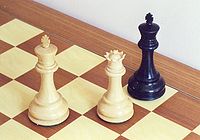Check and checkmate
Check is a term in chess when a player's king is attacked. If the king is in check, the player must find a way to stop the threat; he can not just ignore it. The player must do one of these things:
- Capture the checking piece (with the king or another piece).
- Interpose: put a piece between the checking piece and the king. This only works if the checking piece is a long-distance piece (bishop, rook or queen).
- Move the king to a square which is not threatened.

If none of these works, then it is not a check but checkmate.[1][2]
Checkmate
change| a | b | c | d | e | f | g | h | ||
| 8 | 8 | ||||||||
| 7 | 7 | ||||||||
| 6 | 6 | ||||||||
| 5 | 5 | ||||||||
| 4 | 4 | ||||||||
| 3 | 3 | ||||||||
| 2 | 2 | ||||||||
| 1 | 1 | ||||||||
| a | b | c | d | e | f | g | h | ||
Checkmate (often called mate) is when a player's king is attacked (in check) and there is no way to escape that attack. Or, simply put, the king is under attack and cannot get out of being captured. Giving checkmate is the main goal in chess: a player who is mated loses the game.
History
changeThese rules have been part of chess since its beginning. Until the early 20th century, it was customary to announce "Check!" verbally when making the move. This would be regarded as strange today; players do not address each other in competitive chess except where necessary.
Until the 19th century it was customary to warn one's opponent when attacking his queen: "Check to the queen!" Most players today do not know this was ever done.[3]p74
References
change- ↑ "Laws of Chess". FIDE. Retrieved 2008-11-26.
- ↑ Reuben, Stewart 2005. The chess organiser's handbook. 3rd ed, incorporating the FIDE Laws of Chess. Harding Simpole, Devon.
- ↑ Hooper D. and Whyld K. 1992. The Oxford companion to chess. 2nd ed, Oxford.